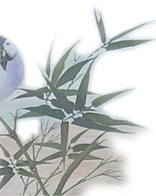|
жҳҘжҷ“вҖ”chЕ«n xiЗҺo
е”җвҖ”tГЎпҪҺЙЎ пјҲ618вҖ”907пјү
еӯҹжө©з„¶вҖ”mГЁnЙЎ hГ orГЎn (689вҖ”740)
жҳҘзң дёҚи§үжҷ“вҖ”chЕ«n miГЎn bГ№ juГ© xiЗҺo,
еӨ„еӨ„й—»е•јйёҹвҖ”chГ№ chГ№ wГ©n tГӯ niЗҺoгҖӮ
еӨңжқҘйЈҺйӣЁеЈ°вҖ”yГЁ lГЎi fД“nЙЎ yЗ” shД“nЙЎпјҢ
иҠұиҗҪзҹҘеӨҡе°‘вҖ”huДҒ luГІ zhД« duЕҚ shЗҺoгҖӮ
иҠұиҗҪзҹҘеӨҡе°‘вҖ”huДҒ luГІ zhД« duЕҚ shЗҺoгҖӮ
жҳҘзң дёҚи§үжҷ“вҖ”chЕ«n miГЎn bГ№ juГ© xiЗҺo,
еӨ„еӨ„й—»е•јйёҹвҖ”chГ№ chГ№ wГ©n tГӯ niЗҺoгҖӮ
еӨңжқҘйЈҺйӣЁеЈ°вҖ”yГЁ lГЎi fД“nЙЎ yЗ” shД“nЙЎпјҢ
иҠұиҗҪзҹҘеӨҡе°‘вҖ”huДҒ luГІ zhД« duЕҚ shЗҺoпјҢ
иҠұиҗҪзҹҘеӨҡе°‘вҖ”huДҒ luГІ zhД« duЕҚ shЗҺoгҖӮ
|#|Chun Xiao A Spring Morning
By Meng Haoran (689вҖ”740)
Tang Dynasty (618вҖ”907)
Sleeping on a spring night, I?ve missed the dawn?
Everywhere I hear the songs of birds?
In the night?s wind and rain,
how many flowers have fallen?
How many flowers have fallen?
Sleeping on a spring night, I?ve missed the dawn?
Everywhere I heard the songs of birds?
In the night?s wind and rain,
how many flowers have fallen?
How many flowers have fallen?
How many flowers have fallen?
|#|еӯҹжө©з„¶ MenЙЎ Haoran пјҲ689-740) was born in Xiangyang, in today's Hubei Province. Apart from spending a short time in the capitalвҖ”Chang'an city, to pursue his career, and traveling in Wu and Yue in today's Jiangsu and Zhejiang, he lived in the Xiangyang area for most of his life.
Meng Haoran is as famous as Wang Wei, because of their friendship and their prominence as Idyll and Landscape Poets.
Succeeding Tao Yuanming (365-427) and Xie Lingyun (385-433),he and Wang Wei (701-761)are regarded as the predecessors of the Idyll and Landscape Poetry in Tang Dynasty.
The language of his poems is very clear and simple, the feelings are kind and true, and they are unique, free and full of breath of life.
He, therefore, had a great reputation in Tang Dynasty. He was a good friend of Wang Wei, Li Bai, Wang Changling and Du Fu and he was admired by them all.
He and Wang Wei are known as вҖңWang and MengвҖқ in the history of Chinese poetry.
|#||#|Chun XiaoвҖ”A Spring Morning is a very simple but quite famous Chinese classical poem by Meng Haoran. In just 4 lines and 20 Chinese characters, it describes a very vivid and fresh glimpse of life.
The first two lines: жҳҘзң дёҚи§үжҷ“пјҢеӨ„еӨ„й—»е•јйёҹ chЕ«n miГЎn bГ№ juГ© xiЗҺo, chГ№ chГ№ wГ©n tГӯ niЗҺoвҖ”Sleeping on a spring night, I've missed the dawn. Everywhere I hear the songs of birds.
The last two lines: еӨңжқҘйЈҺйӣЁеЈ°пјҢиҠұиҗҪзҹҘеӨҡе°‘yГЁ lГЎi fД“nЙЎ yЗ” shД“nЙЎ, huДҒ luГІ zhД« duЕҚ shЗҺoвҖ”In the night?s wind and rain, how many flowers have fallen?
Catching the first feeling at a split second when the poet woke up on the spring morning, this poem writes about what the poet heard and thought, describing the vibrant scenery of spring morning after raining.Instead of describing it from a visual angle, this poem captures the sounds of spring, from the aural angle, writes about what the poet heard from his room rather than what he saw out of the door.In the simplest language, the poem leads readers into a boundless spring scenery,and creates huge room for readers to imagine what that spring morning was like.
Therefore, as we read this poem, it feels like we can hear the singing of the birds, feel the fresh air in the morning, smell the sweet fragrance of the flowers and naturally imagine the activities of the poet.
|#|Catching the sounds of spring (the twitter of the birds, the sounds of the breeze and the rain) to express what the poet felt is the main characteristic of this poem. With this thought, I created a piece of music to go with this short poem in 2005.
But, when I wanted to paint a picture to match the artistic conception of this poem in 2011, I had a new idea. I thought that the last two lines (еӨңжқҘйЈҺйӣЁеЈ°пјҢиҠұиҗҪзҹҘеӨҡе°‘гҖӮпјүyГЁ lГЎi fД“nЙЎ yЗ” shД“nЙЎ, huДҒ luГІ zhД« duЕҚ shЗҺoвҖ”In the night's wind and rain, how many flowers have fallenвҖ”could not only have been the thought of the poet but also have been what the birds were singing.
Therefore, I painted two paintings to match this idea as my assignments at China Central Academy of Fine Arts and at Chinese National Academy of Arts in 2011 and 2012. Let the birds open their mouths to sing and ask how many flowers have fallen in the wind and rain last night.
What do you think of my imagination? Do you agree with me?
If you have any questions, comments or suggestions, please write to shirley@ebridge.cn .
|

